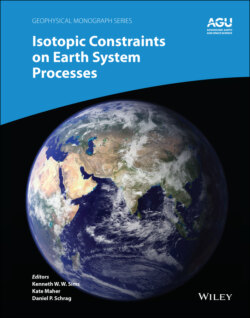Читать книгу Isotopic Constraints on Earth System Processes - Группа авторов - Страница 21
1.1. INTRODUCTION
ОглавлениеIt has long been known from the kinetic theory of gases that the relative mobility of isotopes in a gas depends on their mass. In the limit of a rarefied gas with isotopes of mass mi and mj the ratio of their diffusion coefficients is given by Di/Dj = (mj/mi)0.5. In the case of a trace gas diffusing in a gas of molecular mass M the ratio of the isotope diffusion coefficients depends on the inverse square root of their reduced mass so that Di/Dj = ( μ j/ μ i)0.5 where and similarly for μ j. During the 1960s, physicists did a great deal of work documenting isotope fractionation by diffusion in metals, metal alloys, and metalloids (see Fig. 8 and references in Richter et al., 2009a) as a way of gaining insight into the mechanisms by which diffusion takes place in these materials. Experimental studies documenting kinetic isotope fractionation in silicate materials of interest to geochemistry and cosmochemistry did not start until much later.
The following sections discuss high‐temperature laboratory diffusion experiments that quantified kinetic isotopic fractionations associated with diffusion in silicate liquids and minerals. The results of these experiments are used to identify the processes responsible for chemical gradients in silicate materials from natural settings. Experiments quantifying kinetic isotope fractionation by evaporation from silicate liquids of interest to cosmochemistry are discussed in a final section. The experimental and analytical methods are only briefly described, and the interested reader will find them discussed in detail in the various papers referenced in connection with kinetic isotope fractionation in laboratory and natural samples.
